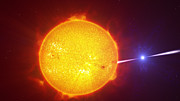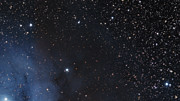Artist’s impression of the exotic binary star system AR Scorpii
AR Scorpii in the constellation of Scorpius
Wide-field view of the sky around the exotic binary star system AR Scorpii
Videos

Artist’s impression video of the exotic binary star system AR Scorpii

Zooming in on the exotic binary star AR Scorpii
Astronomers using ESO’s Very Large
Telescope, along with other telescopes on the ground and in space, have
discovered a new type of exotic binary star. In the system AR Scorpii a
rapidly spinning white dwarf star powers electrons up to almost the
speed of light. These high energy particles release blasts of radiation
that lash the companion red dwarf star, and cause the entire system to
pulse dramatically every 1.97 minutes with radiation ranging from the
ultraviolet to radio. The research will be published in the journal
Nature on 28 July 2016.
In May 2015, a group of amateur astronomers from Germany, Belgium and
the UK came across a star system that was exhibiting behaviour unlike
anything they had ever encountered. Follow-up observations led by the
University of Warwick and using a multitude of telescopes on the ground
and in space [1], have now revealed the true nature of this previously misidentified system.
The star system AR Scorpii, or AR Sco for short, lies in the constellation of Scorpius, 380 light-years from Earth. It comprises a rapidly spinning white dwarf [2], the size of Earth but containing 200 000 times more mass, and a cool red dwarf companion one third the mass of the Sun [3], orbiting one another every 3.6 hours in a cosmic dance as regular as clockwork.
In a unique twist, this binary star system
is exhibiting some brutal behaviour. Highly magnetic and spinning
rapidly, AR Sco’s white dwarf accelerates electrons up to almost the
speed of light. As these high energy particles whip through space, they
release radiation in a lighthouse-like beam which lashes across the face
of the cool red dwarf star, causing the entire system to brighten and
fade dramatically every 1.97 minutes. These powerful pulses include
radiation at radio frequencies, which has never been detected before
from a white dwarf system.
Lead researcher Tom Marsh of the University of Warwick’s Astrophysics Group commented: “AR
Scorpii was discovered over 40 years ago, but its true nature was not
suspected until we started observing it in 2015. We realised we were
seeing something extraordinary within minutes of starting the
observations.”
The observed properties of AR Sco are unique. They are also
mysterious. The radiation across a broad range of frequencies is
indicative of emission from electrons accelerated in magnetic fields,
which can be explained by AR Sco’s spinning white dwarf. The source of
the electrons themselves, however, is a major mystery — it is not clear
whether it is associated with the white dwarf itself, or its cooler
companion.
AR Scorpii was first observed in the early 1970s and regular
fluctuations in brightness every 3.6 hours led it to be incorrectly
classified as a lone variable star [4].
The true source of AR Scorpii’s varying luminosity was revealed thanks
to the combined efforts of amateur and professional astronomers. Similar
pulsing behaviour has been observed before, but from neutron stars —
some of the densest celestial objects known in the Universe — rather
than white dwarfs.
Boris Gänsicke, co-author of the new study, also at the University of Warwick, concludes: "We've
known pulsing neutron stars for nearly fifty years, and some theories
predicted white dwarfs could show similar behaviour. It's very exciting
that we have discovered such a system, and it has been a fantastic
example of amateur astronomers and academics working together."
Notes
[1] The observations underlying this research were carried out on: ESO’s Very Large Telescope (VLT) located at Cerro Paranal, Chile; the William Herschel and Isaac Newton Telescopes of the Isaac Newton Group of telescopes sited on the Spanish island of La Palma in the Canaries; the Australia Telescope Compact Array at the Paul Wild Observatory, Narrabri, Australia; the NASA/ESA Hubble Space Telescope; and NASA's Swift satellite.
[2] White dwarfs form late in the
life cycles of stars with masses up to about eight times that of our
Sun. After hydrogen fusion in a star’s core is exhausted, the internal
changes are reflected in a dramatic expansion into a red giant,
followed by a contraction accompanied by the star’s outer layers being
blown off in great clouds of dust and gas. Left behind is a white dwarf,
Earth-sized but 200 000 times more dense. A single spoonful of the
matter making up a white dwarf would weigh about as much as an elephant
here on Earth.
[3] This red dwarf is an M type star. M
type stars are the most common class in the Harvard classification
system, which uses single letters to group stars according their spectral characteristics.
The famously awkward to remember sequence of classes runs: OBAFGKM, and
is often remembered using the mnemonic Oh Be A Fine Girl/Guy, Kiss Me.
[4] A variable star is one whose
brightness fluctuates as seen from Earth. The fluctuations may be due to
the intrinsic properties of the star itself changing. For instance some
stars noticeably expand and contract. It could also be due to another
object regularly eclipsing the star. AR Scorpii was mistaken for a
single variable star as the orbiting of two stars also results in
regular fluctuations in observed brightness.
More Information
This research was presented in a paper entitled “A radio pulsing
white dwarf binary star”, by T. Marsh et al., to appear in the journal Nature on 28 July 2016.
The team is composed of T.R. Marsh (University of Warwick, Coventry,
UK), B.T. Gänsicke (University of Warwick, Coventry, UK), S. Hümmerich
(Bundesdeutsche Arbeitsgemeinschaft für Veränderliche Sterne e.V.,
Germany; American Association of Variable Star Observers (AAVSO), USA) ,
F.-J. Hambsch (Bundesdeutsche Arbeitsgemeinschaft für Veränderliche
Sterne e.V., Germany; American Association of Variable Star Observers
(AAVSO), USA; Vereniging Voor Sterrenkunde (VVS), Belgium), K. Bernhard
(Bundesdeutsche Arbeitsgemeinschaft für Veränderliche Sterne e.V.,
Germany; American Association of Variable Star Observers (AAVSO),USA),
C.Lloyd (University of Sussex, UK), E. Breedt (University of Warwick,
Coventry, UK), E.R. Stanway (University of Warwick, Coventry, UK), D.T.
Steeghs (University of Warwick, Coventry, UK), S.G. Parsons (Universidad
de Valparaiso, Chile), O. Toloza (University of Warwick, Coventry, UK),
M.R. Schreiber (Universidad de Valparaiso, Chile), P.G. Jonker
(Netherlands Institute for Space Research, The Netherlands; Radboud
University Nijmegen, The Netherlands), J. van Roestel (Radboud
University Nijmegen, The Netherlands), T. Kupfer (California Institute
of Technology, USA), A.F. Pala (University of Warwick, Coventry, UK) ,
V.S. Dhillon (University of Sheffield, UK; Instituto de Astrofisica de
Canarias, Spain; Universidad de La Laguna, Spain), L.K. Hardy
(University of Warwick, Coventry, UK; University of Sheffield, UK), S.P.
Littlefair (University of Sheffield, UK), A. Aungwerojwit (Naresuan
University, Thailand), S. Arjyotha (Chiang Rai Rajabhat University,
Thailand), D. Koester (University of Kiel, Germany), J.J. Bochinski
(The Open University, UK), C.A. Haswell (The Open University, UK), P.
Frank (Bundesdeutsche Arbeitsgemeinschaft für Veränderliche Sterne e.V.,
Germany) and P.J. Wheatley (University of Warwick, Coventry, UK).
ESO is the foremost intergovernmental astronomy organisation in
Europe and the world’s most productive ground-based astronomical
observatory by far. It is supported by 16 countries: Austria, Belgium,
Brazil, the Czech Republic, Denmark, France, Finland, Germany, Italy,
the Netherlands, Poland, Portugal, Spain, Sweden, Switzerland and the
United Kingdom, along with the host state of Chile. ESO carries out an
ambitious programme focused on the design, construction and operation of
powerful ground-based observing facilities enabling astronomers to make
important scientific discoveries. ESO also plays a leading role in
promoting and organising cooperation in astronomical research. ESO
operates three unique world-class observing sites in Chile: La Silla,
Paranal and Chajnantor. At Paranal, ESO operates the Very Large
Telescope, the world’s most advanced visible-light astronomical
observatory and two survey telescopes. VISTA works in the infrared and
is the world’s largest survey telescope and the VLT Survey Telescope is
the largest telescope designed to exclusively survey the skies in
visible light. ESO is a major partner in ALMA, the largest astronomical
project in existence. And on Cerro Armazones, close to Paranal, ESO is
building the 39-metre European Extremely Large Telescope, the E-ELT,
which will become “the world’s biggest eye on the sky”.
Links
Contacts
Tom Marsh
Department of Physics, University of Warwick
Coventry, United Kingdom
Tel: +44 24765 74739
Email: t.r.marsh@warwick.ac.uk
Boris Gänsicke
Department of Physics, University of Warwick
Coventry, United Kingdom
Tel: +44 24765 74741
Email: Boris.Gaensicke@warwick.ac.uk
Richard Hook
ESO Public Information Officer
Garching bei München, Germany
Tel: +49 89 3200 6655
Cell: +49 151 1537 3591
Email: rhook@eso.org
Tom Marsh
Department of Physics, University of Warwick
Coventry, United Kingdom
Tel: +44 24765 74739
Email: t.r.marsh@warwick.ac.uk
Department of Physics, University of Warwick
Coventry, United Kingdom
Tel: +44 24765 74741
Email: Boris.Gaensicke@warwick.ac.uk
Richard Hook
ESO Public Information Officer
Garching bei München, Germany
Tel: +49 89 3200 6655
Cell: +49 151 1537 3591
Email: rhook@eso.org


